

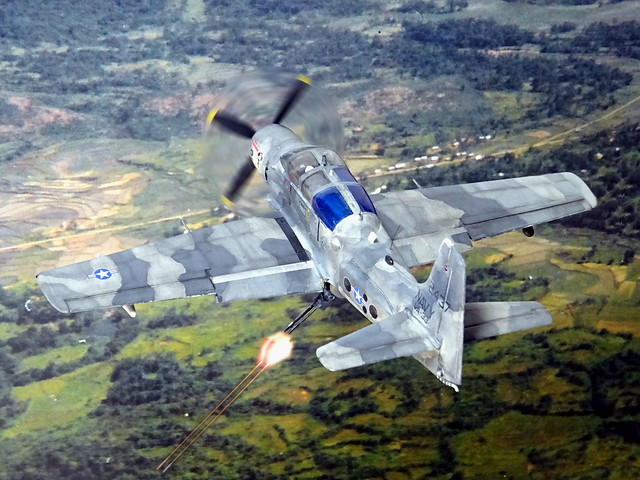
Some background:The OA-1E was a response to the 1963 "tri-service" specification for the Light Armed Reconnaissance Aircraft (LARA) for U.S. Navy, Air Force and Army. The LARA requirement was based on a perceived need for a new type of "jungle fighting" versatile light attack and observation aircraft. Existing military aircraft in the observation role, such as the Cessna O-1 Bird Dog and Cessna O-2 Skymaster, were perceived as obsolescent, with too slow a speed and too small a load capacity for this flexible role.
A total of eleven proposals were submitted, among them were the Grumman Model 134R (a tandem-seat version of the already fielded U.S. Army's OV-1 Mohawk), the Convair Model 48 Charger, the Helio 1320, the Lockheed CL-760, a Martin design, and the North American/Rockwell NA-300. The LARA competition raged on until mid-1964, and it eventually spawned the successful OV-10 Bronco, which made its maiden flight in 1965 and eventually entered frontline service in Vietnam in 1968.
Douglas had proposed the D-885 design to the LARA competition, but had already been working on a concept for an armed military observation and attack aircraft, designed for battlefield surveillance and strike capabilities, in all weather conditions, day and night. This had been a private venture proposal, and USN and USMC approved it under the condition that it would be a cheap solution, being ready for front line tests in mid-1965 – much quicker than the OV-10, which also lacked the all-weather capability at that time.
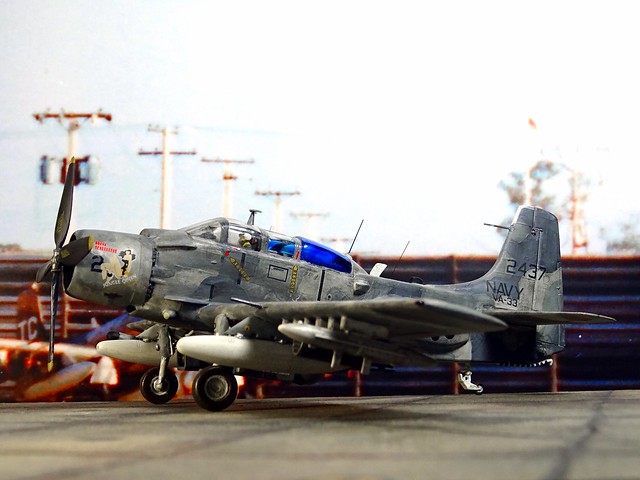
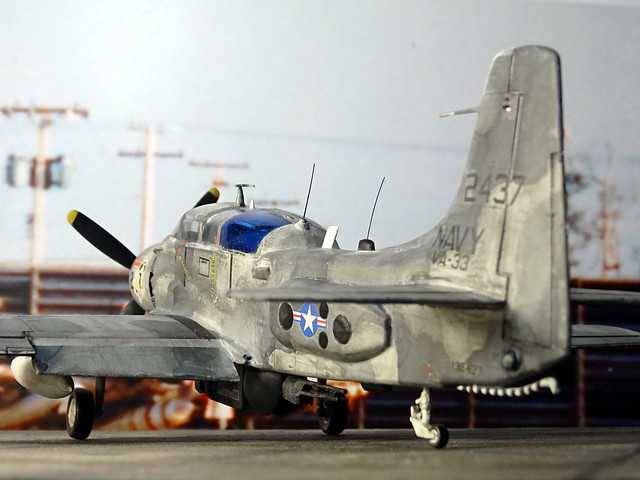
Since time was pressing, the aircraft was based on the AD/A-1 Skyraider airframe and the program christened "Low Altitude Gunship and Obeservation System" (LAGOS). The resulting YOA-1E was based on the "Flying Dumptruck", the A-1E (AD-5) airframe with side-by-side seating and a spacious cockpit which had become necessary for the crew of three: a pilot, a co-pilot/navigator and an observer/gunman, combined with state-of-the-art sensor and weapon equipment plus the technical infrastructure for both.
The YOA-1E's special equipment included a relatively compact, turreted forward looking infrared (FLIR) sensor ball under the fuselage, combined with a laser target designator, a highly innovative feature at the time. The respective ‘Paveway’ series of laser-guided bombs had just been developed by Texas Instruments, starting in 1964, and the LAGOS YOA-1E had been one of the first operational aircraft that could illuminate and deploy laser-guided smart weapons. Other sensors included low-light cameras and an array of IR sensors that were installed in a bulged faring on port side. Several passive radar and IR warning sensors completed the package.
Tactically, the idea was to identify a ground target, lock onto it with the sensors and either mark the target with the laser for other aircraft that would deploy laser-guided ordnance, or circle around the target at maximum cannon range (which was outside of typical small arms fire) at an altitude of 6.000-8.000 feet and suppress or destroy the target with gun fire.

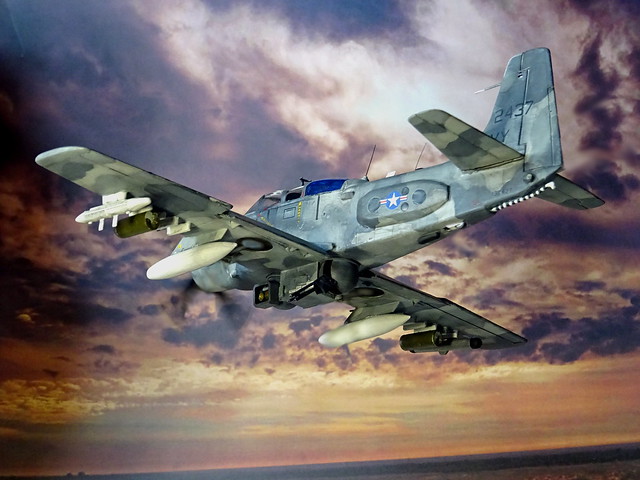
The OA-1E would not carry laser-guided bombs, though, since it lacked proper speed to deploy them effectively, and laser-guided missiles were still far beyond the horizon (the light AGM-114 Hellfire's development started in 1974, and the laser-guided AGM-65C Maverick would enter testing in 1978!).
But the agile and stable aircraft had other benefits: One special feature of the YOA-1E was a turreted, three-barreled 20 mm (.79 in) XM197 gun under the rear fuselage. This gatling gun, also a new development, originally for the AH-1 attack helicopter, was slaved to the FLIR aimpoint and could cover almost the complete lower hemisphere. Using a gun turret instead of fixed armament was expected to improve versatility, esp. against small, mobile targets and at very low altitude. The gun could also fire directly backwards, so that a limited rear defense was provided, too.
The XM197 was supplied from a massive magazine of 1.500 linked rounds that occupied much of the cabin’s rear, with a total capacity including feeder system of 1.600 rounds. This early XM 197 had a cyclic rate of fire of 650 RPM, at a muzzle velocity of 1.030 m/sec. This resulted in a potential constant fire of almost 3 min., even though standard practice was to fire the cannon in 30 to 50 round bursts, in order to save ammunition and to prevent overheating problems.
As a weight compensation measure, two of the A-1E’s original wing-mounted cannons were deleted, as well as the central underfuselage pylon which made way for the sensor/gun installation. The rest of the underwings hardpoints were retained, though, even though offensive ordnance was rarely carried.
In the course of the LAGOS program a total of four A-1E aircraft were modified, and three of them outfited for field testing of equipment and tactics. All of these machines were ready for service in late 1966. The operational trio was immediately transferred to East Asia in order to support the USMC troops, which had been sent to the Vietnam war theatre since March.
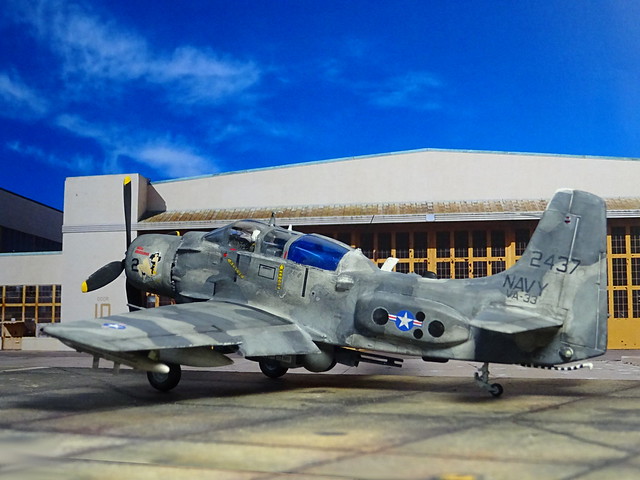
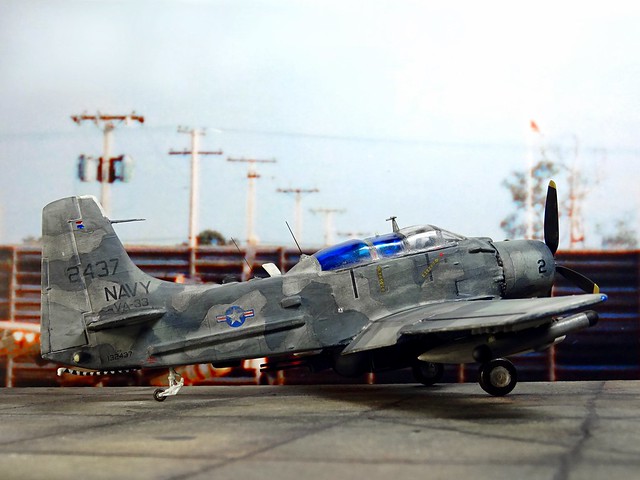
The three operational YOA-1Es were attached to the US Navy’s VA-33, 'Ironhides'. This was a short-lived Attack Squadron, originally based at Naval Station Sangley Point, Philippines, but deployed to Cam Ranh Air Base. There, the Skyraider squadron flew missions next to VAH-21 'Roadrunners', another special unit that operated four highly modfied AP-2H night surveillance and attack versions of the Lockheed P-2 Neptune aircraft. VAH-21 also had a field test task, because the squadron carried out night interdiction and electronic surveillance missions, as part of the USN’s Project TRIM (Trails Roads Interdiction Multi-Sensor).
Flying covert operations, the YOA-1E trio helped a lot in technical development, and the front line test revealed several flaws and problems of the overall concept. Primarily, the early FLIR and laser designator were not reliable under the humid climate of Vietnam.
The XM 197 cannon was troublesome, too. The gun itself worked well, but the ammunition feeding system was prone to jamming – a flaw that kept haunting later, helicopter-mounted variants, too. Anyway, the massive firepower earned the YOA-1E the nickname “The Ewer” and the gun turret turned out to be highly effective.
The OA-1Es even scored a single, documented air victory: an unsuspecting Vietnamese MiG-17PF night fighter was shot down with the XM197 in early 1970, when VA-33's OA-1E ‘01’, 'Pluto', dodged a surprise attack from behind and the gunner instinctively opened defensive fire - not an aimed counterattack, but neverthless successful!


The three OA-1Es were frequently deployed in a wide range of tasks and missions. These started in 1967 with reconnaissance missions at night, but with more and more experience withz the machines, their capabilities and their maintenance, a multitude of assignments were tried and accomplished.
One very successful role was the OA-1E’s use as mini gunships during “Sandy” (pilot recovery) missions, in which they escorted CH-53 rescue helicopters, suppressed enemy fire or supported other escorting A-1s, guiding them to hidden targets.
The LAGOS Skyraiders were also tested in pathfinder missions for faster aircraft, which would deploy their laser-guided Paveway bombs in a more effective fashion from a safe distance and from higher altitudes.
Another field in which the OA-1Es helped to gather tactical information for the later OV-10 was FAC duty. The Skyraider’s high loitering time proved to be very valuable, as well as its rigidity and its sophisticated sensor array.
Furthermore, the three Ewers accomplished aerial radiological reconnaissance, tactical air observation, artillery and naval gunfire spotting, airborne control of tactical air support operations as well as front line, low-level aerial photography. One of the machines (‘03’, 'Journey's End') was even provisionally modified to lay smoke screens, and it was extremely successful.
The aircraft was kept in service by its evaluators for several months and only reluctantly released. The smoke screen system did not catch on, though, due to a perceived lack of missions.
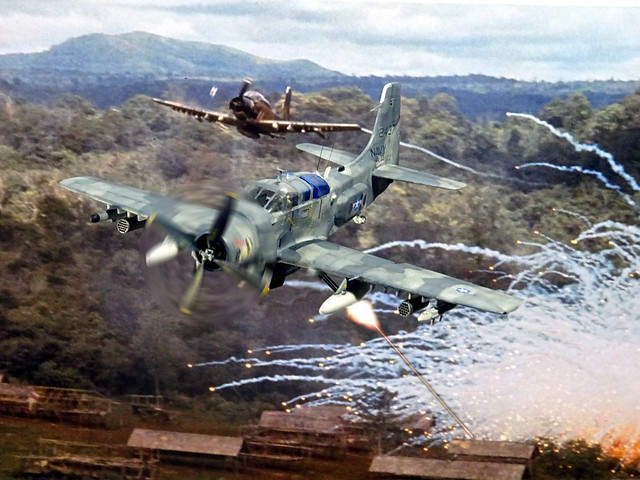
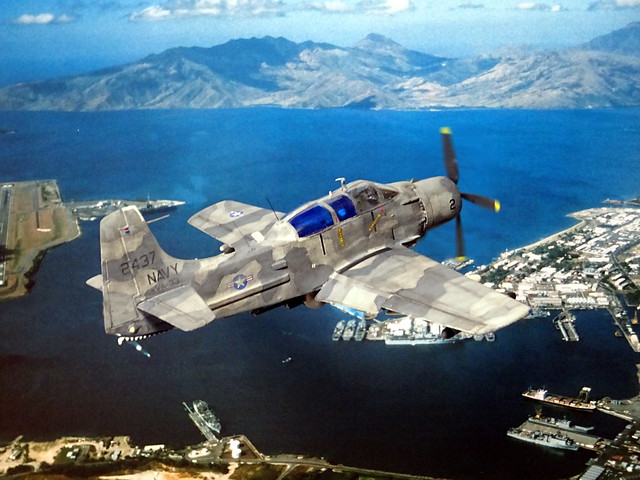
Racked armament in the Vietnam War was usually light. Beyond drop tanks to extend loitering time, typical loads were seven- and nineteen-shot 2.75 in (70 mm) LAU rocket pods with white phosphorus marker rounds or high-explosive rockets or 5” (127 mm) four-shot Zuni rocket pods. Bombs, ADSIDS air-delivered seismic sensors, Mk-6 battlefield illumination flares, and other stores were carried as well. But the heavy equipment load and the XM197’s ammunition (the rounds themselves weighed more than 3.500 lb (1.600 kg)!) naturally limited the external ordnance stores’ volume and made the aircraft rather sluggish.
The LAGOS OA-1E proved to be too heavy and limited for a COIN aircraft, even though it was popular among the crews and basically performed well. The Skyraider airframe could take a lot of punishment and still make it home, and the low speed/low altitude handling was very good, despite the ponderous special equipment. But the aircraft could only be safely deployed in total air superiority conditions, and in the end the modern technology could not make up the old airframe’s weaknesses.
Consequently, the field tests were stopped in late 1970, the three machines taken back to the US and Douglas and further development of the LAGOS concept was halted, even though the insights were transferred to other developments like the OV-10D NOGS for the USMC and the AC-130 gunships for the USAF.


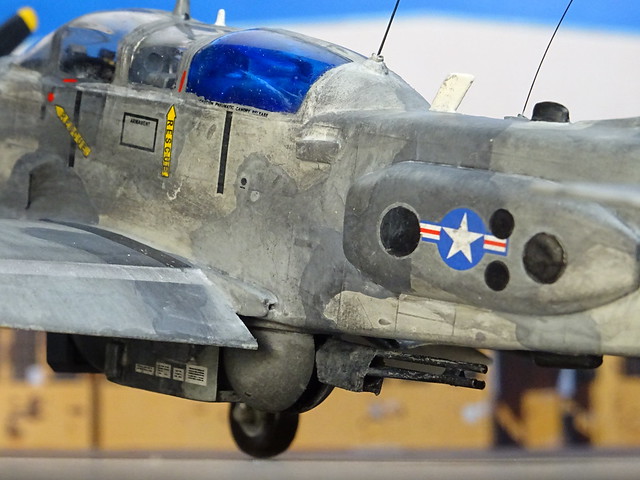

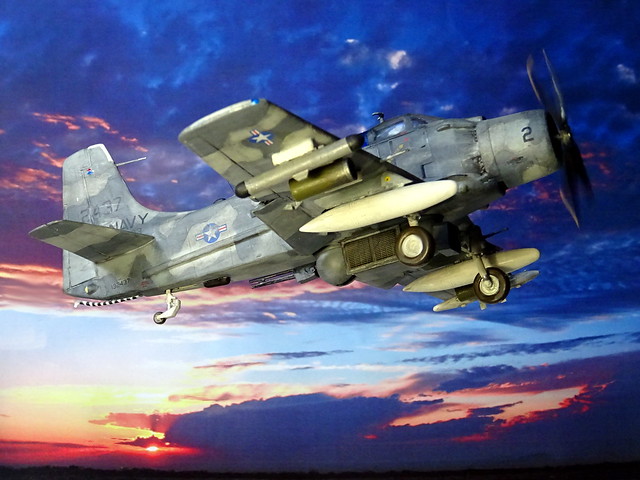
General characteristics:Crew: Three
Length: 38 ft 10 in (11.84 m)
Wingspan: 50 ft 0¼ in (15.25 m)
Height: 15 ft 8¼ in (4.78 m)
Wing area: 400.3 ft² (37.19 m²)
Empty weight: 11,968 lb (5,429 kg)
Loaded weight: 18,106 lb (8,213 kg)
Max. take-off weight: 25,000 lb (11,340 kg)
Powerplant:1× Wright R-3350-26WA radial engine, 2,700 hp (2,000 kW)
Performance:Maximum speed: 322 mph (280 kn, 518 km/h) at 18,000 ft (5,500 m)
Cruise speed: 198 mph (172 kn, 319 km/h)
Range: 1,316 mi (1,144 nmi, 2,115 km)
Service ceiling: 28,500 ft (8,685 m)
Rate of climb: 2,850 ft/min (14.5 m/s)
Wing loading: 45 lb/ft² (220 kg/m²)
Power/mass: 0.15 hp/lb (250 W/kg)
Armament:2× M2 20mm (0.79 in) cannon in the wings
1× XM 197 20mm (0.79 in) cannon in a ventral turret
15 hardpoints for theoretically up to 8,000 lb (3,600 kg) of external ordnance, but rarely used due to the massive ammunition magazine of the XM 197